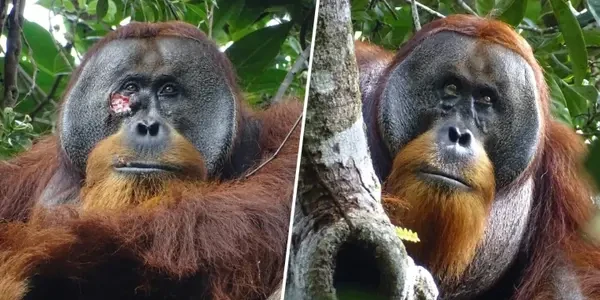In Indonesia, researchers observed an orangutan engaging in behavior suggestive of self-medication, highlighting how certain animals seek relief for their ailments using natural remedies. The Sumatran orangutan named Rakus was observed selecting and consuming leaves from a medicinal tropical plant commonly utilized by humans across Southeast Asia to alleviate pain and reduce inflammation. Subsequently, the adult male applied the plant's juices onto a wound on his right cheek using his fingers. Following this, he pressed the chewed plant material onto the injury, essentially creating a rudimentary bandage, as detailed in a study published in Scientific Reports on Thursday.
Prior studies have documented various species of great apes foraging in forests to procure medicinal substances for self-healing. However, prior to this observation, scientists had not witnessed an animal treating itself in such a manner.
Isabelle Laumer, a biologist at the Max Planck Institute of Animal Behaviour in Konstanz, Germany, and co-author of the study, remarked, “This is the first time that we have observed a wild animal applying a quite potent medicinal plant directly to a wound.”
The incident unfolded in June 2022 within the Gunung Leuser National Park on Sumatra, Indonesia. Researchers noticed Rakus, who exhibited an injury believed to have resulted from conflicts with other male orangutans.
Subsequently, Rakus was seen chewing leaves from a plant identified as Fibraurea tinctoria, refraining from swallowing them, and employing his fingers to apply the plant's juice directly onto the wound.
This plant, known locally as Akar Kuning, is infrequently consumed by orangutans in the peat swamp forest region, where approximately 150 critically endangered Sumatran orangutans reside. Photographic evidence showcased the gradual closure of Rakus's wound over the course of a month without complications. Rakus, estimated to have been born in 1989, possesses flanged features, including prominent cheek pads, characteristic of dominant males in the area.
It is highly probable that the observed behavior constitutes self-medication. Researchers have been studying orangutans in Indonesia's Gunung Leuser National Park since 1994.
Emory University biologist Jacobus de Roode, who was not part of the study, remarked, "It's a solitary observation. However, new behaviors often come to light through single observations."
De Roode further suggested, "Very likely it's self-medication," emphasizing that the orangutan specifically applied the plant to the wound and not to any other part of its body.
Caroline Schuppli, a co-author of the study from Max Planck, speculated that Rakus might have acquired the technique from orangutans residing beyond the park's boundaries, beyond the regular observation of researchers.
Prior instances of primates using plants for medicinal purposes have been documented. Orangutans in Borneo, shared among Brunei, Indonesia, and Malaysia, have been observed rubbing themselves with the juices of medicinal plants, potentially to alleviate bodily discomfort or repel parasites. Similarly, chimpanzees in various locations have been seen chewing bitter plant shoots to alleviate stomach discomfort. Gorillas, chimpanzees, and bonobos have been observed ingesting certain coarse leaves whole to eliminate stomach parasites.
Tara Stoinski, president and chief scientific officer of the nonprofit Dian Fossey Gorilla Fund, who was not involved in the study, pondered, "If such behavior is present in some of our closest living relatives, what insights might it offer into the origins of medicine?"








